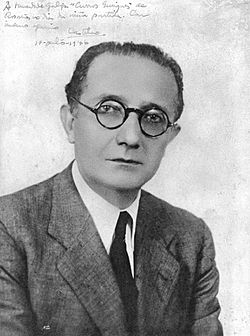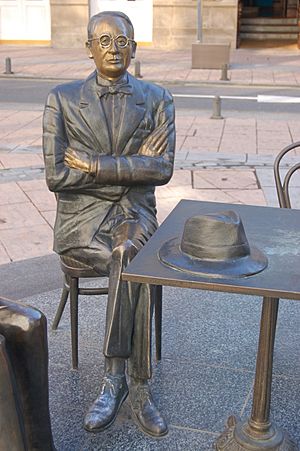Alfonso Daniel Rodríguez Castelao facts for kids
Quick facts for kids
Castelao
|
|
|---|---|

Castelao in 1946.
|
|
| Born | Alfonso Daniel Manuel Rodríguez Castelao 30 January 1886 Rianxo, Galicia, Spain |
| Died | January 7, 1950 (aged 63) Buenos Aires, Argentina |
| Occupation |
|
| Language | Galician |
| Nationality | Galician |
| Citizenship | Galician |
| Alma mater | University of Santiago de Compostela |
| Literary movement | Xeración Nós |
| Notable works | Sempre en Galiza |
| Signature | |
 |
|
Alfonso Daniel Manuel Rodríguez Castelao (born January 30, 1886 – died January 7, 1950) was a famous Galician politician, writer, painter, and doctor. People usually called him Castelao.
He is seen as one of the most important people in creating Galician nationalism. This means he strongly supported Galician identity and culture. He was also a key figure in a cultural movement called Xeración Nós. Castelao helped start and became the president of the Galicianist Party. He also greatly influenced a group of artists known as Os renovadores.
Contents
Castelao's Early Life and Youth (1886–1929)
Alfonso Daniel Rodríguez Castelao was born on January 30, 1886, in Rianxo, a town in Galicia, Spain. His father, Manuel Rodríguez Dios, was a sailor who made sails. His mother was Joaquina Castelao Genme.
When he was young, Castelao lived in Santa Rosa de Toay, Argentina. In 1900, his family moved back to Rianxo.

In 1908, he earned a degree in Medicine from the University of Santiago de Compostela. During his university years, he joined a student music group called the tuna. With this group, he visited Portugal many times.
Castelao finished his medical studies in Madrid in 1909. There, he started to become known for his funny drawings and cartoons. He often said he only studied medicine to make his father happy. He did not practice medicine much, even though he was a doctor. He later settled in Rianxo and joined a political group called Acción Gallega ("Galician Action").
As a caricaturist, Castelao first drew funny everyday scenes. But after the Spanish Civil War, his art changed. He used his paintings to show the terrible things that happened during the war. These paintings showed the cruelty of Fascism. His art also showed normal moments of Galician life and culture.
In 1916, Castelao moved to Pontevedra. There, he joined the Irmandades da Fala ("Brotherhoods of the Language"). Castelao loved Pontevedra very much. He often said he wanted to be seen as a native of that city. He even wished to be buried there instead of Rianxo. Also in 1916, he signed an important declaration for Galician nationalism at the Asembleia Nazonalista de Lugo ("Nationalist Assembly of Lugo").
In 1920, he started a magazine called Nós with Vicente Risco and Otero Pedrayo. That same year, he traveled through France, the Netherlands, and Germany. In 1922, he wrote a novel called Un ollo de vidro. In 1924, he joined the Seminário de Estudos Galegos ("Seminar of Galician Studies"). He also started the Pontevedra Polyphonic Choir, as he enjoyed music. Two years later, in 1926, he published Cousas.
In 1928, he traveled to Brittany to study stone crosses called calvaries. He later published a book about them called As cruces de pedra na Bretaña. This was also the year his only son died at the age of 14.
Castelao's Political Career (1930–1950)

From 1930 onwards, Castelao became even more involved in politics. His whole life and work were focused on politics and his ideas about Galician nationalism. In his book Sempre en Galiza, he wrote that all his work and efforts would always be for the benefit of Galicia.
In 1930, he helped create the Galician Republican Federation. He also took part in meetings for the Galician Nationalist Republican Party. The next year, he published the book Nós. He became the official representative of the Galicianist Party in the Spanish parliament, called the Cortes Generales. In 1934, he published Retrincos and Os dous de sempre. He also re-published Cousas.
Castelao became a member of the Royal Galician Academy in 1933. Soon after, in 1935, the Spanish government sent him away to Badajoz, a city in Extremadura. There, he worked as a civil servant. It was in Badajoz that he began writing his most important work, Sempre en Galiza. In the 1936 elections, he won a seat in the Spanish parliament. This time, he represented the Popular Front group, which included the Galicianist Party.
The Spanish Civil War started while Castelao was in Madrid. He was there to present the results of a vote for the Galician Statute of Autonomy. This law, which gave Galicia more self-rule, was approved by 98% of voters. Castelao and his friend Alexandre Bóveda played a big part in this.
During the war, Castelao helped organize Galician fighters with the Spanish Communist Party. He supported the government of the Second Spanish Republic. As the Nationalist troops advanced, Castelao fled to Valencia. There, he still managed to publish Galicia Martir and Atila en Galicia. Later, he moved to Barcelona.
In 1938, the Spanish government sent him to the Soviet Union, the United States, and Cuba. His mission was to get support for the Republic. From New York City, he traveled to Buenos Aires. In 1941, he performed his play Os vellos non deben de namorarse for the first time. This was Castelao's contribution to Galician theater.
In 1944, while in Buenos Aires, he finished and published Sempre en Galiza. This book was about Galician political ideas. It was a collection of three books and other writings. Sempre en Galiza is considered one of the most advanced political texts of its time. Also that year, he became the first president of the Consello de Galiza. This was the Government of Galicia that was formed by exiles.
In 1945, he started a magazine called Galeuzca with other writers from Catalonia and the Basque Country who were also in exile. This name reminded people of a political alliance from 1933 between Galicia, Catalonia, and the Basque Country. In 1946, he became a Minister in the Spanish Republican government in exile, living in Paris. In 1947, back in Buenos Aires, he was diagnosed with lung cancer. He then published As cruces de pedra na Galiza.
Castelao passed away on January 7, 1950, at the Centro Gallego hospital in Buenos Aires. The Argentine Senate and the City of Buenos Aires built monuments to honor him. Since then, most of his work has been translated into other languages. In 1984, Castelao's remains were brought back to Galicia. He was buried in the Panteón de Galegos Ilustres ("Pantheon of Illustrious Galicians") in Santiago de Compostela.
Castelao's Political Ideas
Castelao was a Galician nationalist. This means he believed strongly in the rights and identity of Galicia. He also supported federalism, which is a way of organizing a country where different regions have some power. He was a pacifist, meaning he believed in peace. He was also a progressist, wanting society to improve, and an internationalist, believing in cooperation between nations.
He accepted the self-rule given to Galicia by the Second Spanish Republic. He saw this as a way to build a future Galician State. He imagined this state could join with other Iberian nations. He also strongly believed in a united Europe. In Sempre en Galiza, he wrote that one of his dreams was to see a "United States of Europe" one day.
Towards the end of his life, Castelao felt a bit let down by the Spanish Republican politicians in exile. He started to think about the benefits of Galicia being a completely independent state.
His Idea of Spain
Castelao often used the word Hespaña instead of España. He took Hespaña from the old name Hispania. For him, Hespaña meant the entire Iberian Peninsula, not just the country known as Spain. He used the word España in a negative way. He saw it as representing the "past" and something to "avoid."
His dream was for a group of "Iberian Nations" to come together to create this new Hespaña. Castelao believed these nations were: Castile, Catalonia, the Basque Country, Portugal, and Galicia. He also thought that besides political changes, there should be cultural changes, like better education.
Castelao did not fully support the usual idea of Iberian Federalism. This idea was about Spain and Portugal joining as two states. Instead, he believed the five real nations of Iberia should join. He felt that the Spanish State should "break up" first. This way, all nations could join the new federation as free-states with equal political power. He disliked that Spain had too much influence from Castile, which he felt was taking over other nations.
In his later years, Castelao seemed to favor the idea of Galicia becoming fully independent. He mentioned this in Sempre en Galiza and in some letters. He wrote: "We are 'secessionist' when we defend the unique values of our nation. We are 'unionist' when we think we need to connect our values with those of the rest of Hespaña and the World." He also said: "The main problem of Spain can only be solved in two ways: federation or secession." In a letter from June 1944, he added: "I would support an open and direct fight for our national independence, if no other way to join with Spain was possible."
Castelao's Views on Language
Castelao spoke both Galician and Spanish. However, he almost always wrote and published in Galician. He was a strong supporter of Galician culture. He believed that the language was the most important thing that united the Galician people. In Sempre en Galiza, he wrote: "If we are still Galician, it is because we speak our own language."
Castelao often criticized how the Spanish language was forced on Galicia. He demanded that Galician become an official language. He wanted it to be the main language used in government and schools.
Castelao thought that Galician and Portuguese not only came from a common origin but also had a "common future." When he traveled to Portugal and sometimes to Brazil, he was amazed at how easily he could speak Galician and understand Portuguese speakers.
He wrote: "Galician is a widely used and helpful language. With small differences, it is spoken in Brazil, Portugal, and in the Portuguese colonies."
Even though he believed this, Castelao never used Portuguese spelling in his writings. He said: "I hope that one day Galician and Portuguese will, slowly and naturally, become one." Castelao wrote his political works mainly for a Galician audience. So, he used a language and spelling that everyone could easily understand. He did use some old Galician words, which were often common in Portuguese. He did this to slowly bring them into everyday speech. For example, he preferred to use Galiza instead of Galicia for the name of the country.
Castelao's Works
- Cego da romería (1913)
- Diario (1921)
- Un ollo de vidro. Memorias d'un esquelete (1922)
- Cousas (1926, 1929)
- Cincoenta homes por dez reás (1930)
- As cruces de pedra na Bretaña (1930)
- Nós (1931)
- Os dous de sempre (1934)
- Retrincos (1934)
- Galicia Mártir (1937)
- Atila en Galicia (1937)
- Milicianos (1938)
- Sempre en Galiza (1944)
- Os vellos non-deben de namorarse (play represented in 1941, published after his death in 1953)
- As cruces de pedra na Galiza (published after his death in 1950)
See Also
 In Spanish: Castelao para niños
In Spanish: Castelao para niños
- Partido Galeguista
- Galician nationalism
- Galician Statute of Autonomy
- Galicianism

